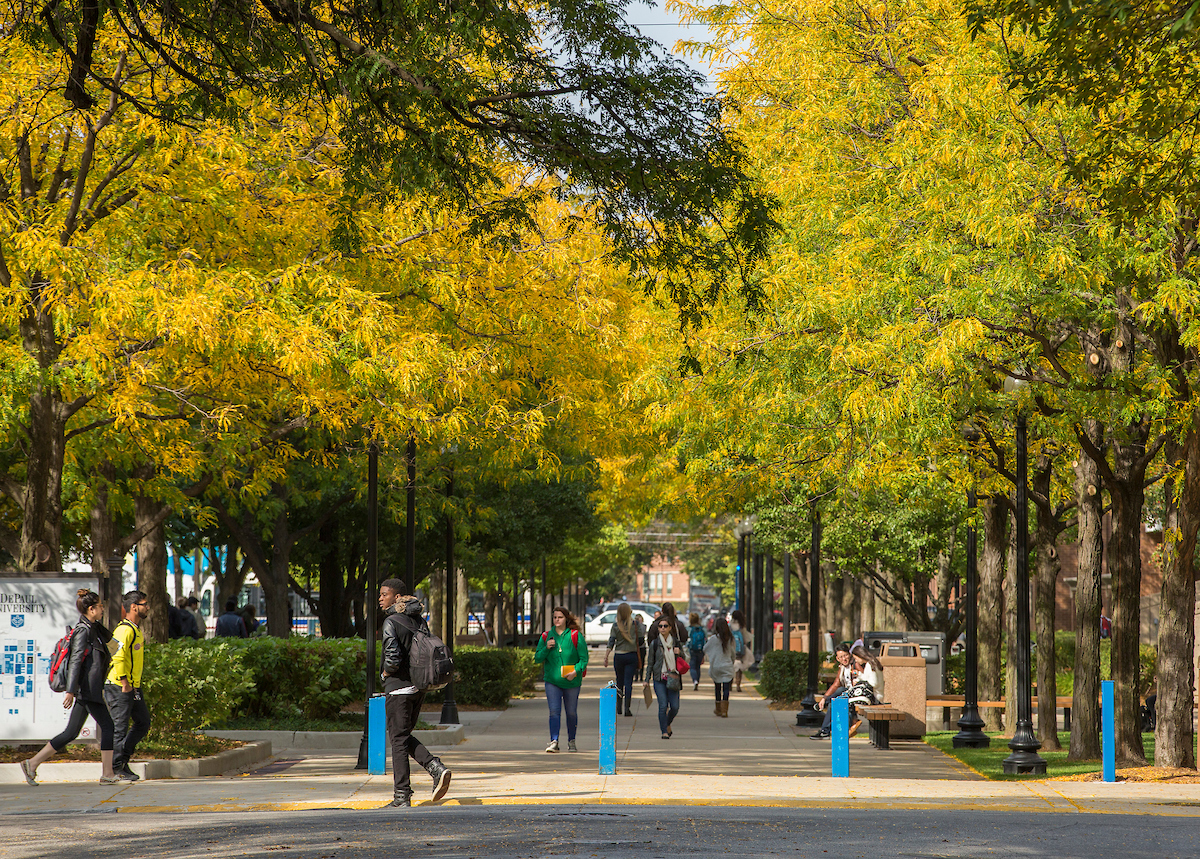 (DePaul University/Jeff Carrion)
(DePaul University/Jeff Carrion)DePaul enrolls 22,437 students this fall, surpassing the budgeted goal by 240 students. The 279,904 credits for which they enrolled exceed projected estimates by 1 percent. These are important outcomes for the university and strong indicators for subsequent quarters.
“Enrollment outcomes are critical at DePaul because we are so heavily dependent on tuition revenue to fund the academic enterprise,” explains David H. Kalsbeek, senior vice president of Enrollment Management and Marketing. “It’s imperative that we reach our budgeted targets so we can continue providing the world-class education our students expect. A strong fall performance relative to budgeted expectations sets the stage for what we anticipate will be solid outcomes throughout the year.”
Freshman class, retention among enrollment highlights
The freshmen class headlines the fall enrollment outcomes. DePaul welcomes 2,575 new first-year students, the second-largest cohort in university history. In addition to size, the class is noteworthy for its academic ability. In fact, the 315 freshmen in the Honors Program is the most ever—an increase of 18 percent over the previous high and 28 percent over last year.
“The University Honors Program presents opportunities for high-achieving students to engage in transformative experiences inside and outside of the classroom, forming a community of scholars united by passion for reason and knowledge,” says Martha Martinez-Firestone, director of the program. “It is the opportunity for a challenging education, combined with Vincentian personalism and commitment to others, that significantly influences our participants’ decision to attend DePaul.”
Last year’s freshmen class also factors directly into the strong fall outcomes. Eighty-six percent of the 2017 cohort returned for their second year at the university, a two percentage point increase over the previous year and the highest first-year retention rate since the 2013 cohort.
“An 86 percent first-year retention rate on the (then) fourth-largest class in university history bodes well for the next few years,” Kalsbeek explains. “A single percentage point means 25 more students are returning and progressing toward their degrees and that has a compounding effect on enrollment over the cohort’s time at DePaul.”
Graduate-level enrollments showed gains as well. Nearly 2 percent more new master’s students enrolled than last year, led by strong gains in CDM, COE and CSH. Overall, graduate and professional credit hours exceeded budgeted targets by over 2 percent.
Another fall highlight is record-setting diversity, a testament to the university’s commitment to mission and the continuation of recent trends. DePaul enrolled 8,710 students of color (39 percent of the student population), both the highest number and highest proportion of students of color in university history.
DePaul’s broad academic portfolio underpins this fall’s successful enrollment outcomes by smoothing the volatility caused by programs in decline with the growth of programs on the upswing. CDM, for example, surpassed its budgeted target by 3 percent, fueled in part by continued growth in their cinematic arts programs. LAS surpassed its budgeted goal by 3 percent as well, benefiting from 100 students enrolling in the recently introduced criminology program.
Flexibility in course delivery is a key enrollment driver because it allows students to balance competing priorities, and enrollment in online courses this fall demonstrates demand is still increasing. Students enrolled in a university record 33,565 credit hours online, a 2 percent increase over last year and 12 percent of all credits.
Despite strong performance, challenges remain
All told, fall enrollment generated $234.2 million in gross tuition revenue. That is the highest ever at DePaul for any quarter, an increase of $3.2 million over last fall and 1 percent over the budgeted target. Net tuition revenue (gross tuition revenue minus institutional financial aid) is estimated at $156 million, 67 percent of gross tuition and also the highest ever for fall quarter.
While enrollment generated record revenues and exceeded projections for the fall, it is important to note that the budgeted headcount target anticipated a decline. Total enrollment is 332 students less than last fall.
A large share of the decline was concentrated in the School for New Learning. As a result of the discontinuation of the individualized degree program, SNL enrollment declined 194 students from fall 2017, a 20 percent drop and 58 percent of the university’s decline year-over-year. As a result of a comprehensive, 18-month review of the adult learner landscape, the university will launch the School for Continuing and Professional Studies on July 1, 2019, to address the growing market for credit-hour based, market-responsive professional studies degrees, non-degree programs and stackable credentials.
Transfer enrollment remained volatile as the competitive environment continues to intensify and the pre-transfer enrollment at the community colleges in the region continues to get smaller. Transfers are down 29 students from last year and 30 students less than the budgeted target.
Innovation is critical as the university responds to challenges in the transfer market. This year, DePaul launched a partnership with Harper College in Palatine. Harper students can complete a DePaul degree entirely at the Harper campus, providing them a lower-cost, flexible degree program while developing a transfer pipeline for DePaul. The partnership with Harper is already showing results. Transfer enrollment from Harper increased 52 percent over last year, and for the first-time ever became DePaul’s largest community college feeder with 126 transfer students.
Strategic plan lays groundwork for future enrollment success
The university’s new strategic plan, “Grounded in Mission: The Plan for DePaul 2024,” provides the framework and vision for building upon the university’s past accomplishments to ensure a successful and sustainable future. Enrollment will play a key role in achieving the plan’s ambitious goals, and DePaul has reason to be optimistic, Kalsbeek says.
“Enrollment outcomes are intertwined with the priorities in the strategic plan. The focus it places on retention and new program development, for instance, gives us opportunities to build and grow. But as with any plan, it will only be as successful as we are in implementing it. In that, we are fortunate, because of the extraordinarily talented and dedicated faculty and staff at DePaul.”